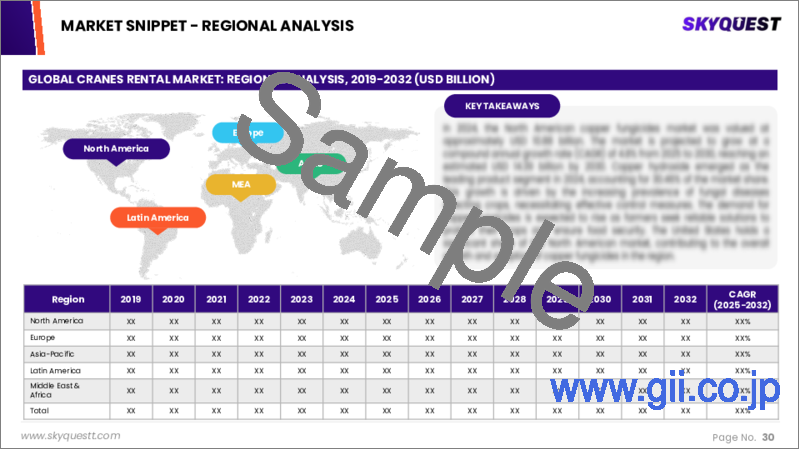|
|
市場調査レポート
商品コード
1656019
クレーンレンタルの市場規模、シェア、成長分析:製品別、用途別、プロジェクト期間別、地域別 - 産業予測 2025~2032年Cranes Rental Market Size, Share, and Growth Analysis, By Product (Mobile Crane, Fixed Crane), By Application (Construction & mining, Utility), By Project Duration, By Region - Industry Forecast 2025-2032 |
||||||
|
|||||||
| クレーンレンタルの市場規模、シェア、成長分析:製品別、用途別、プロジェクト期間別、地域別 - 産業予測 2025~2032年 |
|
出版日: 2025年02月13日
発行: SkyQuest
ページ情報: 英文 202 Pages
納期: 3~5営業日
|
全表示
- 概要
- 目次
クレーンレンタル市場規模は2023年に501億米ドルとなり、予測期間(2025~2032年)のCAGRは5.4%で、2024年の528億1,000万米ドルから2032年には804億3,000万米ドルに成長すると予測されています。
世界のクレーンレンタル市場は、建設、インフラプロジェクト、産業の進歩の影響を受け、活気ある成長を遂げています。重い荷物を持ち上げたり運んだりするのに不可欠な道具であるクレーンは、建設、製造、エネルギー、物流などの分野で不可欠です。主な市場促進要因には、長期的な投資コストを排除する柔軟なレンタルソリューションに対する需要の高まりとともに、都市化や大規模プロジェクトが含まれます。テレマティクスやGPS追跡などの技術の進歩により、作業効率と安全性が向上しており、環境に優しいクレーンへのシフトは持続可能性への取り組みと一致しています。経済変動とさまざまな規制環境が市場力学を形成しており、新興経済国は急速な成長を見せ、成熟市場は近代化を優先しています。パンデミック後の復興は建設活動の復活を促し、コラボレーションとデジタル化に基づく競争戦略への道を開いています。
目次
イントロダクション
- 調査の目的
- 調査範囲
- 定義
調査手法
- 情報調達
- 二次と一次データの方法
- 市場規模予測
- 市場の前提条件と制限
エグゼクティブサマリー
- 世界市場の見通し
- 供給と需要の動向分析
- セグメント別機会分析
市場力学と見通し
- 市場概要
- 市場規模
- 市場力学
- 促進要因と機会
- 抑制要因と課題
- ポーターの分析
主な市場の考察
- 重要成功要因
- 競合の程度
- 主な投資機会
- 市場エコシステム
- 市場の魅力指数(2024年)
- PESTEL分析
- マクロ経済指標
- バリューチェーン分析
- 価格分析
クレーンレンタル市場規模:製品別
- 市場概要
- 移動式クレーン
- トラックローダークレーン
- ラフテレーンクレーン
- 全地形型クレーン
- クローラクレーン
- 固定クレーン
- モノレールクレーン
- スティフレッグクレーン
- タワークレーン
- ガントリークレーン
クレーンレンタル市場規模:用途別
- 市場概要
- 建設・鉱業
- 移動式クレーン
- 固定クレーン
- ユーティリティ
- 移動式クレーン
- 固定クレーン
- 製造業
- 移動式クレーン
- 固定クレーン
- 交通機関
- 移動式クレーン
- 固定クレーン
- 石油・ガス
- 移動式クレーン
- 固定クレーン
クレーンレンタル市場規模:プロジェクト期間別
- 市場概要
- 短期
- 長期
クレーンレンタル市場規模
- 北米
- 米国
- カナダ
- 欧州
- ドイツ
- スペイン
- フランス
- 英国
- イタリア
- その他欧州地域
- アジア太平洋地域
- 中国
- インド
- 日本
- 韓国
- その他アジア太平洋地域
- ラテンアメリカ
- ブラジル
- その他ラテンアメリカ地域
- 中東・アフリカ
- GCC諸国
- 南アフリカ
- その他中東・アフリカ
競合情報
- 上位5社の比較
- 主要企業の市場ポジショニング(2024年)
- 主な市場企業が採用した戦略
- 最近の市場動向
- 企業の市場シェア分析(2024年)
- 主要企業の企業プロファイル
- 企業の詳細
- 製品ポートフォリオ分析
- 企業のセグメント別シェア分析
- 収益の前年比比較(2022~2024年)
主要企業プロファイル
- Mammoet(Netherlands)
- Sarens(Belgium)
- Maxim Crane Works(US)
- Bigge Crane and Rigging Co.(US)
- Barnhart Crane and Rigging(US)
- Liebherr(Germany)
- Konecranes(Finland)
- Terex Corporation(US)
- Tadano(Japan)
- Grove Worldwide(US)
- Al Faris(UAE)
- Action Construction Equipment Limited(India)
- Sanghvi Movers Limited(India)
- All Erection & Crane Rental(US)
- Lampson International(US)
- ALE(UK)
- J.F. Brennan Company(US)
- Hoffmann Equipment(US)
- United Rentals(US)
結論と提言
Cranes Rental Market size was valued at USD 50.1 billion in 2023 and is poised to grow from USD 52.81 billion in 2024 to USD 80.43 billion by 2032, growing at a CAGR of 5.4% during the forecast period (2025-2032).
The Global Cranes Rental Market is experiencing vibrant growth, significantly influenced by ongoing construction, infrastructure projects, and industrial advancements. As essential tools for lifting and transporting heavy loads, cranes are vital across sectors such as construction, manufacturing, energy, and logistics. Key market drivers include urbanization and mega projects, alongside the rising demand for flexible rental solutions that eliminate long-term investment costs. Advancements in technology, like telematics and GPS tracking, are improving operational efficiency and safety, while the shift toward eco-friendly cranes aligns with sustainability initiatives. Economic fluctuations and varying regulatory environments shape market dynamics, with emerging economies showing rapid growth and mature markets prioritizing modernization. Post-pandemic recovery is fostering a resurgence in construction activities, paving the way for competitive strategies based on collaboration and digitalization.
Top-down and bottom-up approaches were used to estimate and validate the size of the Cranes Rental market and to estimate the size of various other dependent submarkets. The research methodology used to estimate the market size includes the following details: The key players in the market were identified through secondary research, and their market shares in the respective regions were determined through primary and secondary research. This entire procedure includes the study of the annual and financial reports of the top market players and extensive interviews for key insights from industry leaders such as CEOs, VPs, directors, and marketing executives. All percentage shares split, and breakdowns were determined using secondary sources and verified through Primary sources. All possible parameters that affect the markets covered in this research study have been accounted for, viewed in extensive detail, verified through primary research, and analyzed to get the final quantitative and qualitative data.
Cranes Rental Market Segments Analysis
Global Cranes Rental Market is segmented by Product, Application, Project Duration and region. Based on Product, the market is segmented into Mobile Crane and Fixed Crane. Based on Application, the market is segmented into Construction & mining, Utility, Manufacturing, Transportation and Oil & gas. Based on Project Duration, the market is segmented into Short-term and Long-term. Based on region, the market is segmented into North America, Europe, Asia Pacific, Latin America and Middle East & Africa.
Driver of the Cranes Rental Market
The global crane rental market is primarily propelled by the continuous infrastructure development projects taking place around the world. The rapid pace of urbanization, coupled with the expansion of transportation networks and the construction of both commercial and residential properties, significantly amplifies the need for cranes. These essential machines facilitate the lifting of heavy materials and support various construction activities, which are crucial for timely and efficient project completion. As these factors converge, they create a robust demand for crane rental services, making it a vital component of the evolving construction landscape.
Restraints in the Cranes Rental Market
The cranes rental market faces significant challenges due to economic fluctuations. In times of economic downturn or uncertainty, construction and infrastructure projects often face delays or cancellations, which subsequently reduces the demand for crane rental services. Additionally, industries grappling with economic hardships may limit their expenditures, further hindering the growth of the overall market. This sensitivity to economic conditions presents a substantial restraint, as frequent market uncertainties can lead to unpredictable demand patterns and affect the financial stability of crane rental providers. Consequently, the cranes rental market must navigate these economic variables to sustain and enhance its growth trajectory.
Market Trends of the Cranes Rental Market
The cranes rental market is witnessing a transformative trend driven by the integration of technological advancements and telematics. Companies are increasingly adopting telematics systems across their fleets, enabling remote monitoring that enhances operational efficiency through real-time data on crane location, usage, and maintenance. This shift not only facilitates better resource allocation but also minimizes downtime with timely maintenance alerts. Additionally, the incorporation of IoT sensors and GPS tracking further improves safety and utilization rates, streamlining rental processes. As these technologies become standard, the cranes rental industry is poised for greater efficiency, safety, and customer satisfaction, establishing a competitive edge in a dynamic market.
Table of Contents
Introduction
- Objectives of the Study
- Scope of the Report
- Definitions
Research Methodology
- Information Procurement
- Secondary & Primary Data Methods
- Market Size Estimation
- Market Assumptions & Limitations
Executive Summary
- Global Market Outlook
- Supply & Demand Trend Analysis
- Segmental Opportunity Analysis
Market Dynamics & Outlook
- Market Overview
- Market Size
- Market Dynamics
- Drivers & Opportunities
- Restraints & Challenges
- Porters Analysis
- Competitive rivalry
- Threat of substitute
- Bargaining power of buyers
- Threat of new entrants
- Bargaining power of suppliers
Key Market Insights
- Key Success Factors
- Degree of Competition
- Top Investment Pockets
- Market Ecosystem
- Market Attractiveness Index, 2024
- PESTEL Analysis
- Macro-Economic Indicators
- Value Chain Analysis
- Pricing Analysis
Global Cranes Rental Market Size by Product & CAGR (2025-2032)
- Market Overview
- Mobile Crane
- Truck loader crane
- Rough terrain crane
- All terrain crane
- Crawler crane
- Fixed Crane
- Monorail crane
- Stiffleg crane
- Tower crane
- Gantry crane
Global Cranes Rental Market Size by Application & CAGR (2025-2032)
- Market Overview
- Construction & mining
- Mobile Crane
- Fixed Crane
- Utility
- Mobile Crane
- Fixed Crane
- Manufacturing
- Mobile Crane
- Fixed Crane
- Transportation
- Mobile Crane
- Fixed Crane
- Oil & gas
- Mobile Crane
- Fixed Crane
Global Cranes Rental Market Size by Project Duration & CAGR (2025-2032)
- Market Overview
- Short-term
- Long-term
Global Cranes Rental Market Size & CAGR (2025-2032)
- North America (Product, Application, Project Duration)
- US
- Canada
- Europe (Product, Application, Project Duration)
- Germany
- Spain
- France
- UK
- Italy
- Rest of Europe
- Asia Pacific (Product, Application, Project Duration)
- China
- India
- Japan
- South Korea
- Rest of Asia-Pacific
- Latin America (Product, Application, Project Duration)
- Brazil
- Rest of Latin America
- Middle East & Africa (Product, Application, Project Duration)
- GCC Countries
- South Africa
- Rest of Middle East & Africa
Competitive Intelligence
- Top 5 Player Comparison
- Market Positioning of Key Players, 2024
- Strategies Adopted by Key Market Players
- Recent Developments in the Market
- Company Market Share Analysis, 2024
- Company Profiles of All Key Players
- Company Details
- Product Portfolio Analysis
- Company's Segmental Share Analysis
- Revenue Y-O-Y Comparison (2022-2024)
Key Company Profiles
- Mammoet (Netherlands)
- Company Overview
- Business Segment Overview
- Financial Updates
- Key Developments
- Sarens (Belgium)
- Company Overview
- Business Segment Overview
- Financial Updates
- Key Developments
- Maxim Crane Works (US)
- Company Overview
- Business Segment Overview
- Financial Updates
- Key Developments
- Bigge Crane and Rigging Co. (US)
- Company Overview
- Business Segment Overview
- Financial Updates
- Key Developments
- Barnhart Crane and Rigging (US)
- Company Overview
- Business Segment Overview
- Financial Updates
- Key Developments
- Liebherr (Germany)
- Company Overview
- Business Segment Overview
- Financial Updates
- Key Developments
- Konecranes (Finland)
- Company Overview
- Business Segment Overview
- Financial Updates
- Key Developments
- Terex Corporation (US)
- Company Overview
- Business Segment Overview
- Financial Updates
- Key Developments
- Tadano (Japan)
- Company Overview
- Business Segment Overview
- Financial Updates
- Key Developments
- Grove Worldwide (US)
- Company Overview
- Business Segment Overview
- Financial Updates
- Key Developments
- Al Faris (UAE)
- Company Overview
- Business Segment Overview
- Financial Updates
- Key Developments
- Action Construction Equipment Limited (India)
- Company Overview
- Business Segment Overview
- Financial Updates
- Key Developments
- Sanghvi Movers Limited (India)
- Company Overview
- Business Segment Overview
- Financial Updates
- Key Developments
- All Erection & Crane Rental (US)
- Company Overview
- Business Segment Overview
- Financial Updates
- Key Developments
- Lampson International (US)
- Company Overview
- Business Segment Overview
- Financial Updates
- Key Developments
- ALE (UK)
- Company Overview
- Business Segment Overview
- Financial Updates
- Key Developments
- J.F. Brennan Company (US)
- Company Overview
- Business Segment Overview
- Financial Updates
- Key Developments
- Hoffmann Equipment (US)
- Company Overview
- Business Segment Overview
- Financial Updates
- Key Developments
- United Rentals (US)
- Company Overview
- Business Segment Overview
- Financial Updates
- Key Developments





